Exploring Pedestrian Satisfaction in Old and New Town: An Impact-Asymmetry Analysis
Abstract
1. Introduction
2. Literature Review
3. Research Method
3.1. Impact-Asymmetry Analysis
3.2. Gradient Boosting Decision Trees Model
4. Data and Variables
5. Results
5.1. Attribute Importance
5.2. Improvement Priorities
- (1)
- High-impact range: RIOS > (RIOS [average value] + RIOS [maximum value])/2
- (2)
- Medium-impact range: (RIOS [average value] + RIOS [minimum value])/2 ≤ RIOS ≤ (RIOS [average value] + RIOS [maximum value])/2
- (3)
- Low-impact range: (RIOS [average value] + RIOS [minimum value])/2 < RIOS
6. Conclusions
Author Contributions
Funding
Institutional Review Board Statement
Informed Consent Statement
Data Availability Statement
Acknowledgments
Conflicts of Interest
References
- Gibson, J.M.; Rodriguez, D.; Dennerlein, T.; Mead, J.; Hasch, T.; Meacci, G.; Levin, S. Predicting urban design effects on physical activity and public health: A case study. Health Place 2015, 35, 79–84. [Google Scholar] [CrossRef]
- Frank, L.D.; Andresen, M.A.; Schmid, T.L. Obesity relationships with community design, physical activity, and time spent in cars. Am. J. Prev. Med. 2004, 27, 87–96. [Google Scholar] [CrossRef]
- Van Dyck, D.; Cardon, G.; Deforche, B.; Sallis, J.F.; Owen, N.; De Bourdeaudhuij, I. Neighborhood SES and walkability are related to physical activity behavior in Belgian adults. Prev. Med. 2010, 50, S74–S79. [Google Scholar] [CrossRef]
- Rundle, A.G.; Sheehan, D.M.; Quinn, J.W.; Bartley, K.; Eisenhower, D.; Bader, M.M.D.; Lovasi, G.S.; Neckerman, K.M. Using GPS data to study neighborhood walkability and physical activity. Am. J. Prev. Med. 2016, 50, E65–E72. [Google Scholar] [CrossRef]
- Todd, M.; Adams, M.A.; Kurka, J.; Conway, T.L.; Cain, K.L.; Buman, M.P.; Frank, L.D.; Sallis, J.F.; King, A.C. GIS-measured walkability, transit, and recreation environments in relation to older Adults’ physical activity: A latent profile analysis. Prev. Med. 2016, 93, 57–63. [Google Scholar] [CrossRef]
- Muraleetharan, T.; Hagiwara, T. Overall level of service of urban walking environment and its influence an pedestrian route choice behavior—Analysis of pedestrian travel in Sapporo, Japan. Transp. Res. Rec. 2007, 2002, 7–17. [Google Scholar] [CrossRef]
- Rye, T.; Hrelja, R. Policies for reducing car traffic and their problematisation. Lessons from the mobility strategies of British, Dutch, German and Swedish cities. Sustainability 2020, 12, 8170. [Google Scholar] [CrossRef]
- Su, C.; Lu, J.; Xu, P. Analysis of urban transport carbon emissions and low-carbon development mode: A case study of Shanghai. J. Highw. Transp. Res. Dev. 2012, 29, 142–148. [Google Scholar]
- Zeyu, W. Experience and enlightenment of street space construction in Melbourne Central District from a humanistic perspective. Shanghai Urban Plan. Rev. 2020, 99–104. [Google Scholar] [CrossRef]
- Gray, S.F.; Kellas, A. Covid-19 Has Highlighted the Inadequate, and Unequal, Access to High Quality Green Spaces. Bmj Opin. 2020, 3. Available online: https://www.bristolhealthpartners.org.uk/news/covid-19-has-highlighted-the-inadequate-and-unequal-access-to-high-quality-green-spaces/ (accessed on 11 November 2022).
- Liu, D.; Kwan, M.P.; Kan, Z.H. Assessing job-access inequity for transit-based workers across space and race with the Palma ratio. Urban Res. Pract. 2021, 15, 746–772. [Google Scholar] [CrossRef]
- Kweon, B.S.; Rosenblatt-Naderi, J.; Ellis, C.D.; Shin, W.H.; Danies, B.H. The effects of pedestrian environments on walking behaviors and perception of pedestrian safety. Sustainability 2021, 13, 8728. [Google Scholar] [CrossRef]
- Yuan, L.; Xiaohan, G.; Linchuan, Y.; Jing, G. Research on walking environment satisfaction of residents based on ordered probit model—A Case Study of Gulangyu. Chin. Landsc. Archit. 2020, 36, 90–94. [Google Scholar] [CrossRef]
- Villaveces, A.; Nieto, L.A.; Ortega, D.; Rios, J.F.; Medina, J.J.; Gutierrez, M.I.; Rodriguez, D. Pedestrians’ perceptions of walkability and safety in relation to the built environment in Cali, Colombia, 2009–2010. Inj. Prev. 2012, 18, 291–297. [Google Scholar] [CrossRef]
- Yintao, L. Walkability evaluation based on people’s use of facilities by walking. Urban Plan. Forum 2013, 5, 113–118. [Google Scholar]
- Zhao, L.; Bian, Y.; Rong, J.; LIU, X.M. Pedestrian LOS of urban sidewalks based on orderly logistic regression. J. Transp. Syst. Eng. 2014, 14, 131–138. [Google Scholar] [CrossRef]
- Kim, S.; Park, S.; Lee, J.S. Meso- or micro-scale? Environmental factors influencing pedestrian satisfaction. Transp. Res. D 2014, 30, 10–20. [Google Scholar] [CrossRef]
- Chen, Y.; Wang, Q.; Xi, W.; Mao, J. Influence Of spatial form on pedestrians. Planners 2017, 33, 74–80. [Google Scholar]
- Zhou, X. The analysis of influential sactors in urban walking environment: An empirical study on 16 walking spaces of Melbourne, Australia. Planners 2017, 33, 197–202. [Google Scholar]
- Ji, X.; Zhang, K. Quantitative study on walkability based on urban spatial morphology: Taking Chengdu Shaocheng area as an example. J. Xi’an Univ. Archit. Technol. Nat. Sci. Ed. 2020, 52, 563–571. [Google Scholar] [CrossRef]
- Tan, S.; Cao, F.; Yang, J. The study on spatial elements of health-supportive environment in residential streets promoting residents’ walking trips. Int. J. Environ. Res. Public Health 2020, 17, 5198. [Google Scholar] [CrossRef]
- Long, Y.; Li, L.; Li, S.; Chen, L.; Pan, Z.; Yao, Y.; Chen, M.; Wang, Y.; Quan, J.; Zhang, L.; et al. Measurment of street Walking Environment Index for urban vitality centers in Chinese cities. S. Archit. 2021, 114–120. [Google Scholar] [CrossRef]
- Oh, M.; Kim, S.; Choi, Y.; Pratt, S. Examination of benefits sought by hiking tourists: A comparison of impact-range performance analysis and impact asymmetry analysis. Asia Pac. J. Tour. Res. 2019, 24, 850–864. [Google Scholar] [CrossRef]
- Mikulic, J.; Prebezac, D. Evaluating hotel animation programs at Mediterranean sun-and-sea resorts: An impact-asymmetry analysis. Tour. Manag. 2011, 32, 688–696. [Google Scholar] [CrossRef]
- Chen, P.-Z.; Liu, W.-Y. Assessing management performance of the national forest park using impact range-performance analysis and impact-asymmetry analysis. For. Policy Econ. 2019, 104, 121–138. [Google Scholar] [CrossRef]
- Back, K.-J.; Lee, C.-K. Determining the Attributes of Casino Customer Satisfaction: Applying Impact-Range Performance and Asymmetry Analyses. J. Travel Tour. Mark. 2015, 32, 747–760. [Google Scholar] [CrossRef]
- Elith, J.; Leathwick, J.R.; Hastie, T. A working guide to boosted regression trees. J. Anim. Ecol. 2008, 77, 802–813. [Google Scholar] [CrossRef] [PubMed]
- Ding, C.; Wu, X.; Yu, G.; Wang, Y. A gradient boosting logit model to investigate driver’s stop-or-run behavior at signalized intersections using high-resolution traffic data. Transp. Res. C 2016, 72, 225–238. [Google Scholar] [CrossRef]
- Dong, W.; Cao, X.; Wu, X.; Dong, Y. Examining pedestrian satisfaction in gated and open communities: An integration of gradient boosting decision trees and impact-asymmetry analysis. Landsc. Urban Plan. 2019, 185, 246–257. [Google Scholar] [CrossRef]
- Wu, X.; Cao, X.; Ding, C. Exploring rider satisfaction with arterial BRT: An application of impact asymmetry analysis. Travel Behav. Soc. 2020, 19, 82–89. [Google Scholar] [CrossRef]
- Fang, D.; Xue, Y.; Cao, J.; Sun, S. Exploring satisfaction of choice and captive bus riders: An impact asymmetry analysis. Transp. Re. D 2021, 93, 102798. [Google Scholar] [CrossRef]
- Lan, J.; Xue, Y.; Fang, D.; Zheng, Q. Optimal strategies for elderly public transport service based on impact-asymmetry analysis: A case study of Harbin. Sustainability 2022, 14, 1320. [Google Scholar] [CrossRef]
- Albayrak, T.; Caber, M. Penalty-Reward-Contrast Analysis: A review of its application in customer satisfaction research. Total Qual. Manag. Bus. Excell. 2013, 24, 1288–1300. [Google Scholar] [CrossRef]
- Lai, I.K.W.; Hitchcock, M. Sources of satisfaction with luxury hotels for new, repeat, and frequent travelers: A PLS impact-asymmetry analysis. Tour. Manag. 2017, 60, 107–129. [Google Scholar] [CrossRef]
- Ding, C.; Cao, X.; Wang, Y. Synergistic effects of the built environment and commuting programs on commute mode choice. Transp. Res. Pt. A Policy Pract. 2018, 118, 104–118. [Google Scholar] [CrossRef]
- GB/T 51439-2021; Standard for Urban Pedestrian and Bicycle Transport System Planning. China Architecture Publishing&Media Co., Ltd.: Beijing, China. Available online: http://www.gbstandards.org/GB_standard_english.asp?code=GB/T%2051439-2021 (accessed on 1 October 2021).
- Mikulić, J.; Prebežac, D. Prioritizing improvement of service attributes using impact range-performance analysis and impact-asymmetry analysis. Manag. Serv.Qual. Int. J. 2008, 18, 559–576. [Google Scholar] [CrossRef]
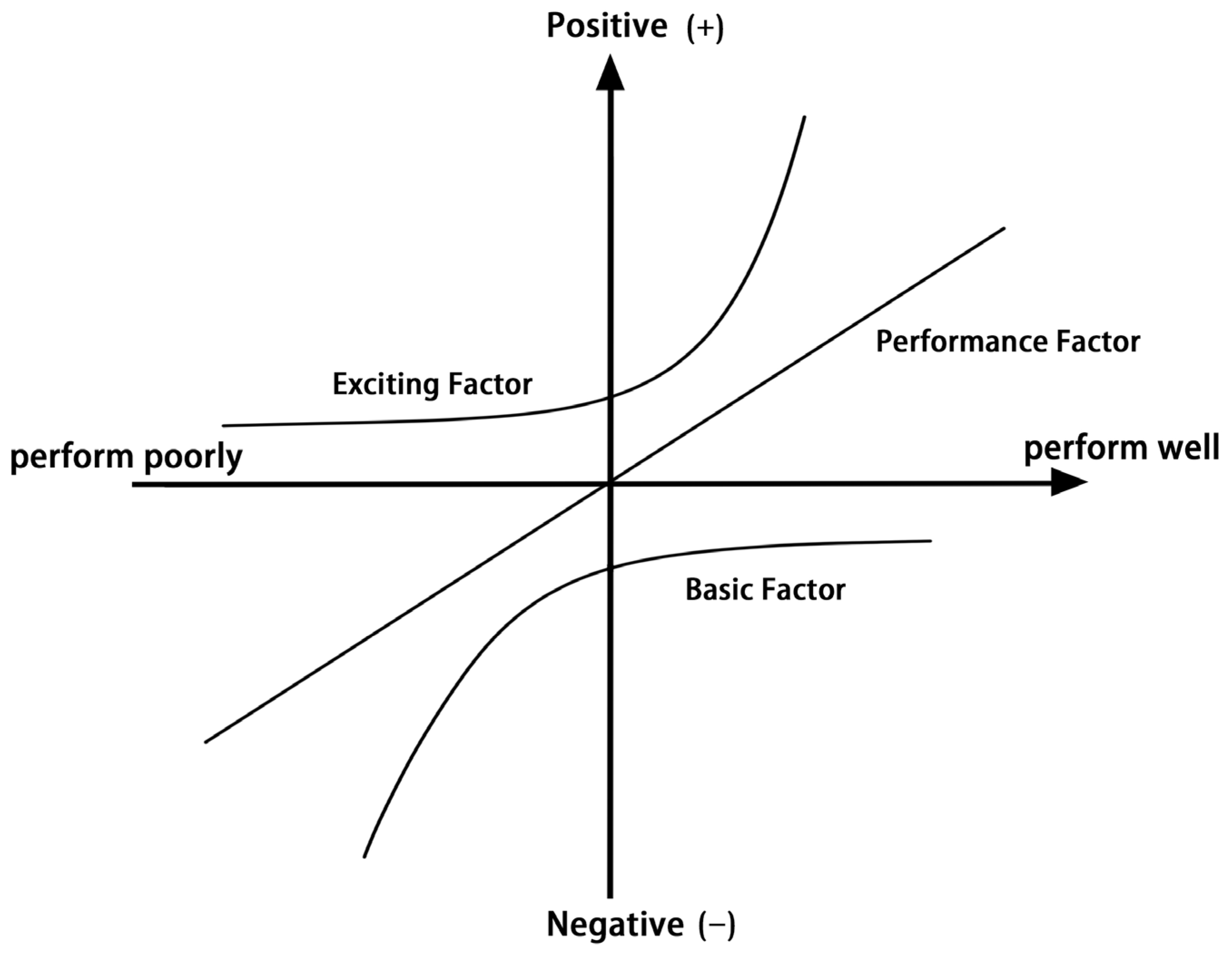
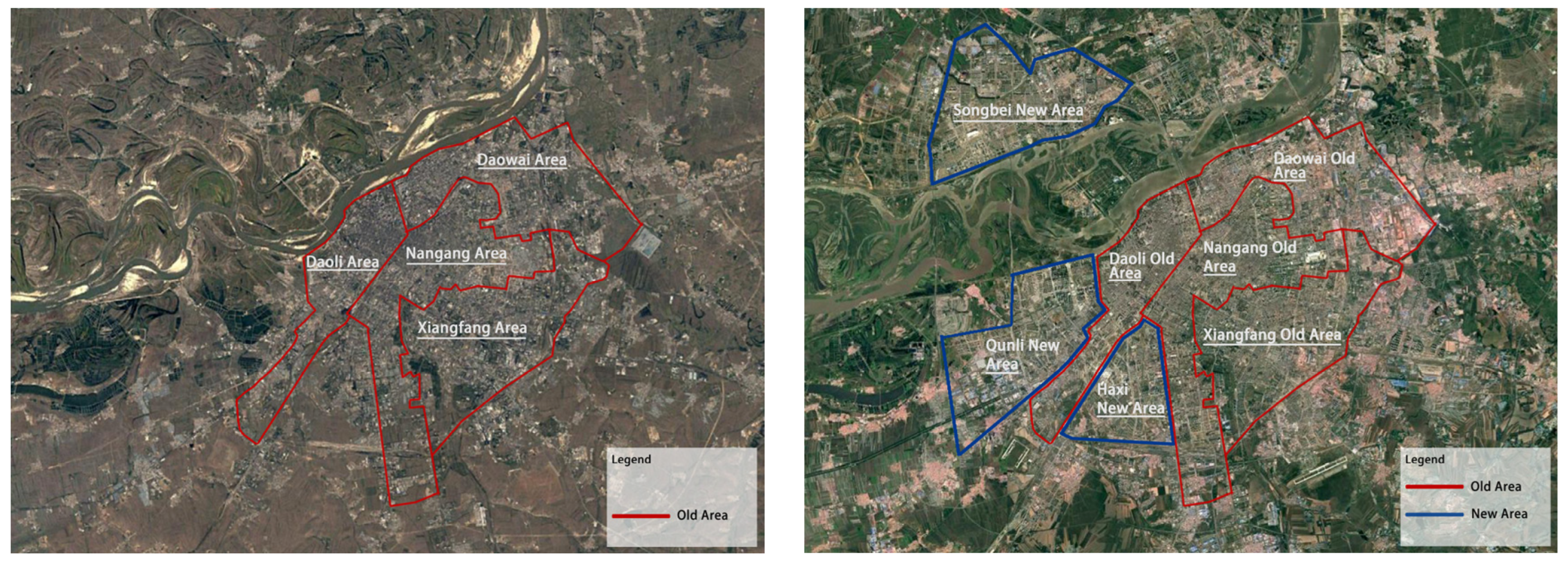
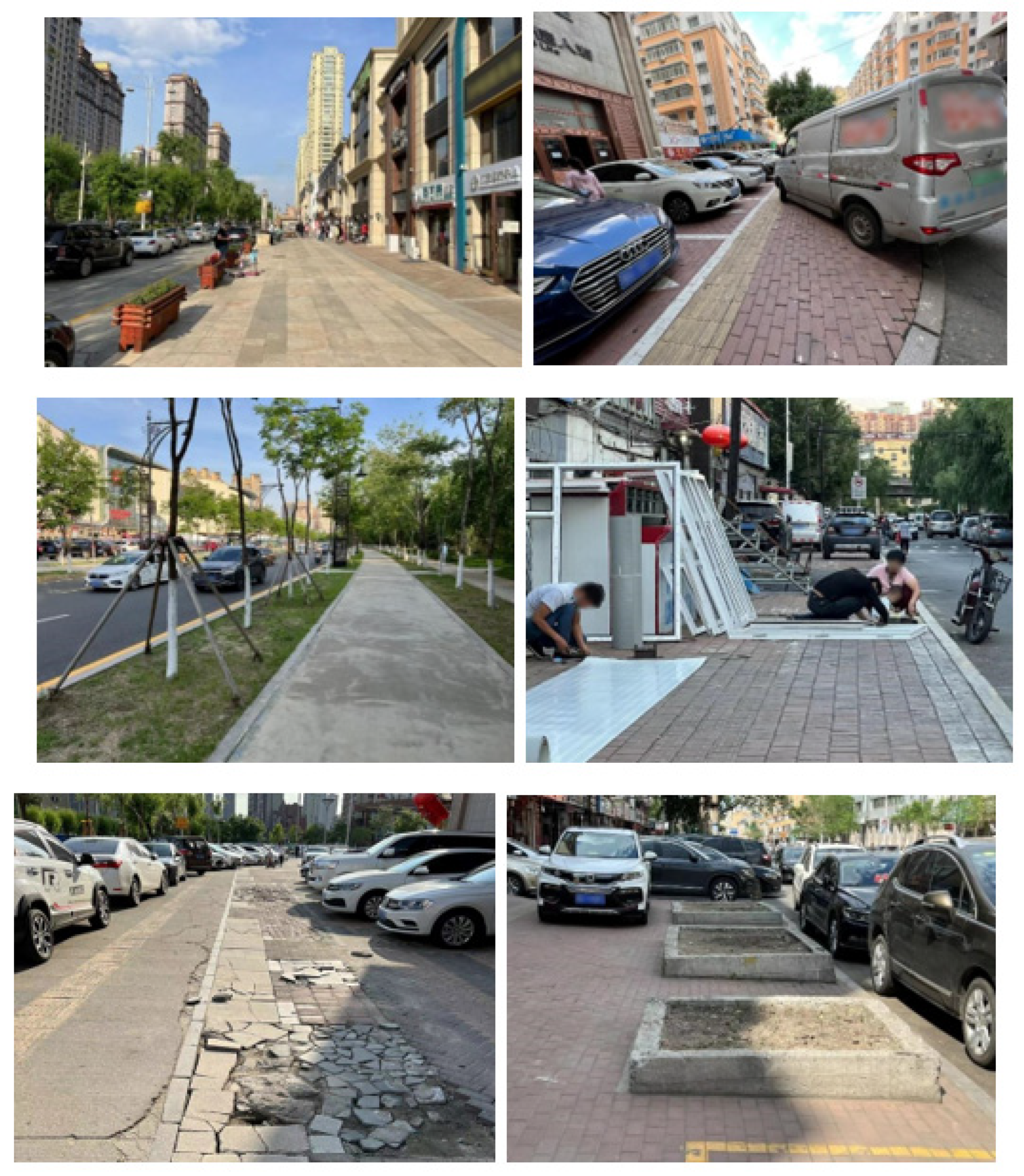
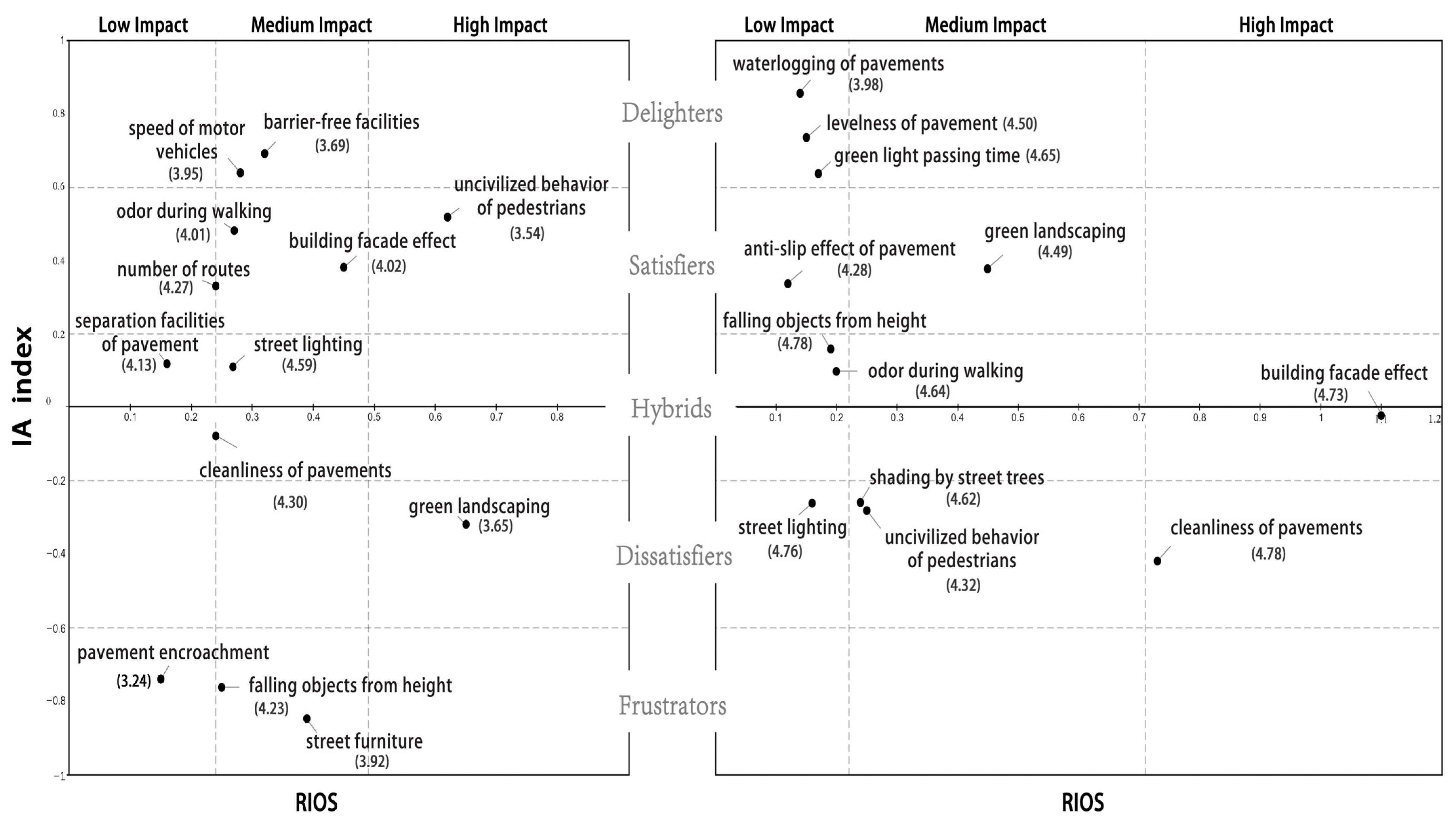
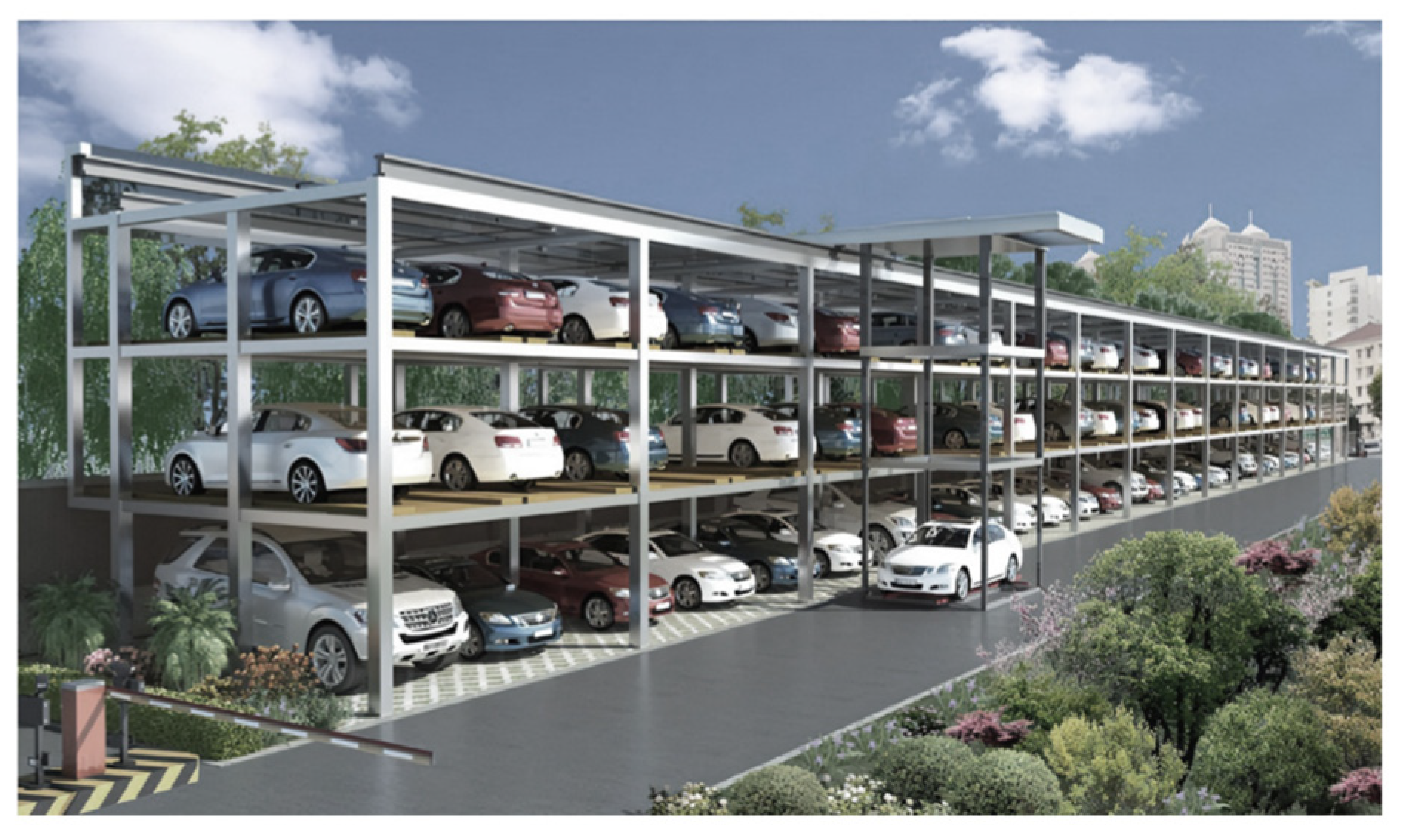
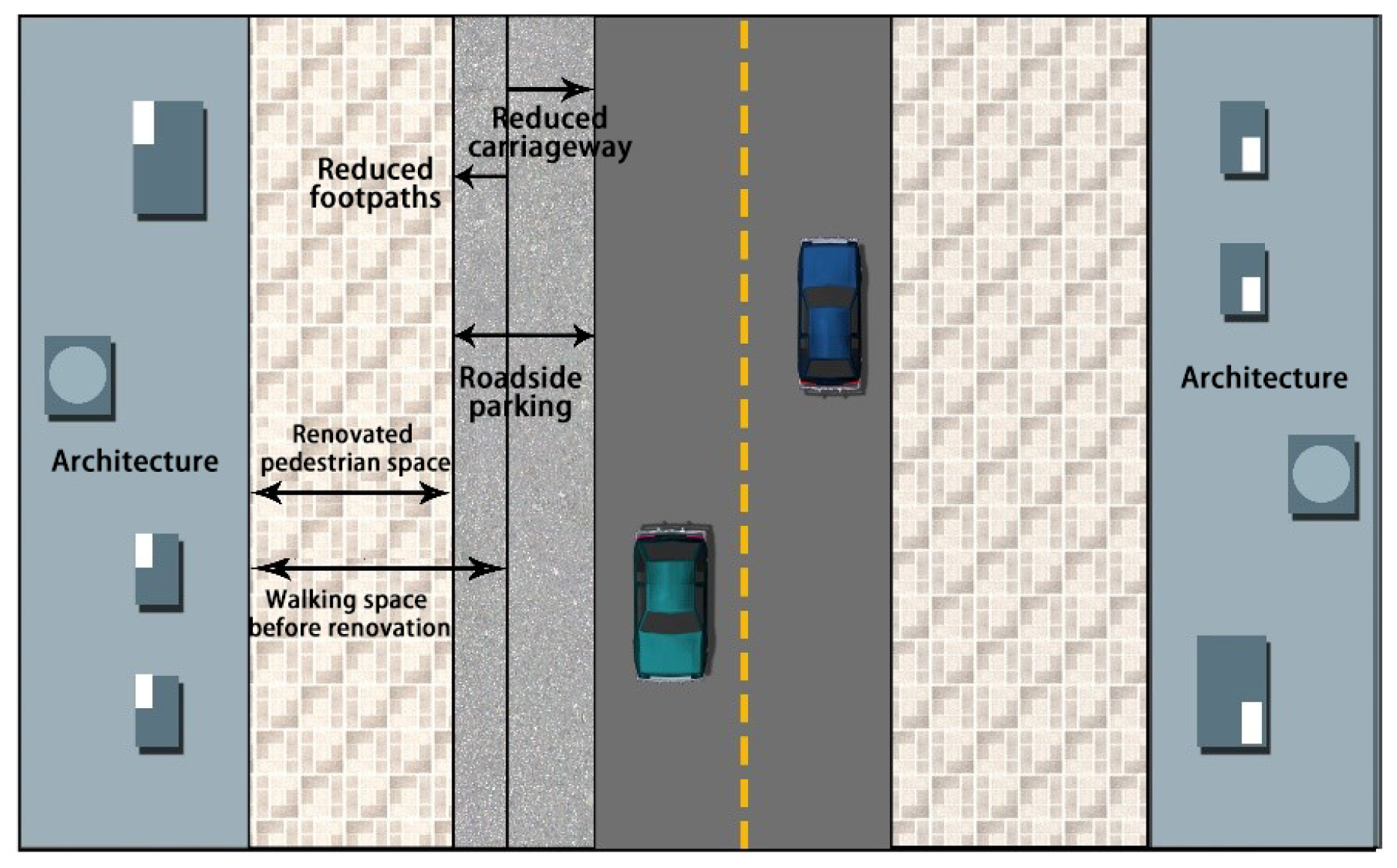
| Three-Factor | Categories | Categories Basis | Delineated Thresholds | Features |
|---|---|---|---|---|
| Exciting factor | Delighter | Reward >> penalty | IA index ≥ 0.6 | Significant increase in overall satisfaction after delivery |
| Satisfier | Reward > penalty | 0.6 > IA index > 0.2 | Increase in overall satisfaction after delivery | |
| Performance factor | Hybrid | Reward ≈ penalty | 0.2 ≥ IA index ≥ −0.2 | Satisfaction or not, the overall satisfaction increases and decreases accordingly |
| Basic factor | Dissatisfier | Reward < penalty | −0.2 > IA index > −0.6 | Decrease in overall satisfaction when not delivered |
| Frustrator | Reward << penalty | −0.6 ≥ IA index | Significantly decreases overall satisfaction when not delivered |
| First-Level Indicator | Secondary Indicators | Tertiary Indicators |
|---|---|---|
| Safety | Human–vehicle conflict | Speed of motor vehicles |
| Yield to pedestrians | ||
| Non-motorized vehicle interference | ||
| Separation facilities of pavement | ||
| Pavement encroachment (cars, merchant stalls, etc.) | ||
| Public security | Falling objects from a height | |
| The safety of walking at night (fear of robbery, theft, etc.) | ||
| Safety facilities | Street lighting | |
| Barrier-free facilities | ||
| Convenience | Road network structure | Number of routes available (walk to shops, markets, banks, etc.) |
| Crossing facilities (zebra crossings, flyovers, underpasses, etc.) | ||
| Pavement management | Green light passing time | |
| Timeliness of snow removal | ||
| Distance to service facilities | Walking distance to the event venue (plazas, parks, etc.) | |
| Walking distance to bus stop | ||
| Walking distance to service facilities (food markets, pharmacies, banks, supermarkets, restaurants, etc.) | ||
| Comfort | Pavement quality | Anti-slip effect of pavement |
| Width of pavement | ||
| Levelness of pavement | ||
| Waterlogging of pavements | ||
| Pavement pollution | Cleanliness of pavements | |
| Noise during walking (construction, machinery operation, etc.) | ||
| Odor during walking (smoke from restaurants, odor from rubbish heaps, etc.) | ||
| Pavement greenery | Shading by street trees | |
| Hearing birds chirping while walking | ||
| Aesthetics | Pedestrian streetscape | Building facade effect (style of the building, building facade decoration, shop plaque design, etc.) |
| Green landscaping (flowers, greenery, etc.) | ||
| Street furniture (seats, litter bins, street signs, etc.) | ||
| Social atmosphere | Uncivilized behavior of pedestrians (spitting, walking dogs without a leash, etc.) | |
| Recreational activities for residents |
| Characteristics | Classification | Old Town (%) | New Town (%) |
|---|---|---|---|
| Gender | Male | 43.2 | 45.9 |
| Female | 56.8 | 54.1 | |
| Age | 18–34 | 36.2 | 40.9 |
| 35–49 | 39.2 | 37.5 | |
| 50–64 | 15.7 | 13.9 | |
| 65–94 | 8.9 | 7.7 | |
| Education level | Elementary school or lower | 12.1 | 4.1 |
| Middle school | 12.2 | 17.1 | |
| High school/vocational high school | 27.2 | 14.7 | |
| Bachelor’s degree/associate degree | 37.7 | 41.6 | |
| Graduate degrees | 10.8 | 22.5 | |
| Occupation | Students | 18.7 | 14.8 |
| Office workers | 39.1 | 48.1 | |
| Individual workers | 13.7 | 10.5 | |
| Freelancers | 12.5 | 15.1 | |
| Retirees | 11.9 | 5.5 | |
| Others | 4.1 | 6.0 |
| Rank | Old Urban Areas Factors | Relative Influence (%) | New Urban Area Factors | Relative Influence (%) |
|---|---|---|---|---|
| 1 | Uncivilized behavior of pedestrians | 12.8 | Building facade effect | 24.5 |
| 2 | Green landscaping | 11.6 | Cleanliness of pavements | 14.7 |
| 3 | Building facade effect | 7.8 | Green landscaping | 9.8 |
| 4 | Street furniture | 7.3 | Falling objects from height | 4.3 |
| 5 | Barrier-free facilities | 5.7 | Uncivilized behavior of pedestrians | 3.9 |
| 6 | Speed of motor vehicles | 4.6 | Street lighting | 3.4 |
| 7 | Falling objects from height | 4.4 | Shading by street trees | 2.9 |
| 8 | Cleanliness of pavements | 4.1 | Levelness of pavement | 2.7 |
| 9 | Street lighting | 4.0 | Odor during walking | 2.7 |
| 10 | Odor during walking | 3.8 | Green light passing time | 2.3 |
| 11 | Number of routes available | 2.3 | Waterlogging of pavements | 2.0 |
| 12 | Separation facilities of pavement | 2.2 | Anti-slip effect of pavement | 2.0 |
| 13 | Pavement encroachment | 1.9 |
| Walking Environment Factors | SGP | DGP | RIOS | IA Index | Classification | Mean Satisfaction |
|---|---|---|---|---|---|---|
| Old town | ||||||
| Green landscaping | 0.38 | 0.62 | 0.65 | −0.24 | Dissatisfier | 3.65 |
| Uncivilized behavior of pedestrians | 0.76 | 0.24 | 0.62 | 0.52 | Satisfier | 3.54 |
| Building facade effect | 0.69 | 0.31 | 0.45 | 0.38 | Satisfier | 4.02 |
| Street furniture | 0.08 | 0.92 | 0.39 | −0.84 | Frustrator | 3.92 |
| Barrier-free facilities | 0.84 | 0.16 | 0.32 | 0.68 | Delighter | 3.69 |
| Speed of motor vehicles | 0.82 | 0.18 | 0.28 | 0.64 | Delighter | 3.95 |
| Street lighting | 0.55 | 0.44 | 0.27 | 0.12 | Hybrid | 4.59 |
| Odor during walking | 0.74 | 0.26 | 0.27 | 0.48 | Satisfier | 4.01 |
| Falling objects from height | 0.12 | 0.88 | 0.25 | −0.76 | Frustrator | 4.23 |
| Cleanliness of pavements | 0.46 | 0.54 | 0.24 | −0.08 | Hybrid | 4.30 |
| Number of routes available | 0.67 | 0.33 | 0.24 | 0.34 | Satisfier | 4.27 |
| Separation facilities of pavement | 0.56 | 0.44 | 0.16 | 0.12 | Hybrid | 4.13 |
| Pavement encroachment | 0.13 | 0.87 | 0.15 | −0.74 | Frustrator | 3.24 |
| New town | ||||||
| Building facade effect | 0.49 | 0.51 | 1.1 | −0.02 | Hybrid | 4.73 |
| Cleanliness of pavements | 0.29 | 0.71 | 0.73 | −0.42 | Dissatisfier | 4.78 |
| Green landscaping | 0.69 | 0.31 | 0.45 | 0.38 | Satisfier | 4.49 |
| Uncivilized behavior of pedestrians | 0.36 | 0.64 | 0.25 | −0.28 | Dissatisfier | 4.32 |
| Shading by street trees | 0.37 | 0.63 | 0.24 | −0.26 | Dissatisfier | 4.62 |
| Odor during walking | 0.55 | 0.45 | 0.2 | 0.1 | Hybrid | 4.64 |
| Falling objects from height | 0.58 | 0.42 | 0.19 | 0.16 | Hybrid | 4.78 |
| Green light passing time | 0.82 | 0.18 | 0.17 | 0.64 | Delighter | 4.65 |
| Street lighting | 0.37 | 0.63 | 0.16 | −0.26 | Dissatisfier | 4.76 |
| Levelness of pavement | 0.87 | 0.13 | 0.15 | 0.74 | Delighter | 4.5 |
| Waterlogging of pavements | 0.93 | 0.07 | 0.14 | 0.86 | Delighter | 3.98 |
| Anti-slip effect of pavement | 0.67 | 0.33 | 0.12 | 0.34 | Satisfier | 4.28 |
Disclaimer/Publisher’s Note: The statements, opinions and data contained in all publications are solely those of the individual author(s) and contributor(s) and not of MDPI and/or the editor(s). MDPI and/or the editor(s) disclaim responsibility for any injury to people or property resulting from any ideas, methods, instructions or products referred to in the content. |
© 2023 by the authors. Licensee MDPI, Basel, Switzerland. This article is an open access article distributed under the terms and conditions of the Creative Commons Attribution (CC BY) license (https://creativecommons.org/licenses/by/4.0/).
Share and Cite
Han, L.; Fang, D.; Sun, S.; Zhao, L.; Zheng, Q.; Lan, J.; Wang, X. Exploring Pedestrian Satisfaction in Old and New Town: An Impact-Asymmetry Analysis. Sustainability 2023, 15, 2414. https://doi.org/10.3390/su15032414
Han L, Fang D, Sun S, Zhao L, Zheng Q, Lan J, Wang X. Exploring Pedestrian Satisfaction in Old and New Town: An Impact-Asymmetry Analysis. Sustainability. 2023; 15(3):2414. https://doi.org/10.3390/su15032414
Chicago/Turabian StyleHan, Liu, Dewei Fang, Shan Sun, Lixuan Zhao, Qian Zheng, Jingxu Lan, and Xue Wang. 2023. "Exploring Pedestrian Satisfaction in Old and New Town: An Impact-Asymmetry Analysis" Sustainability 15, no. 3: 2414. https://doi.org/10.3390/su15032414
APA StyleHan, L., Fang, D., Sun, S., Zhao, L., Zheng, Q., Lan, J., & Wang, X. (2023). Exploring Pedestrian Satisfaction in Old and New Town: An Impact-Asymmetry Analysis. Sustainability, 15(3), 2414. https://doi.org/10.3390/su15032414





